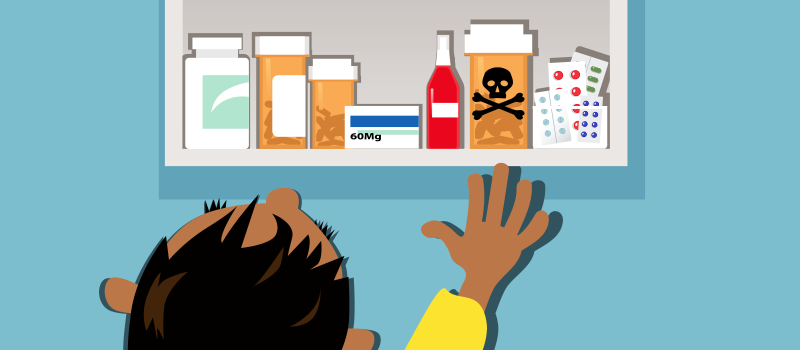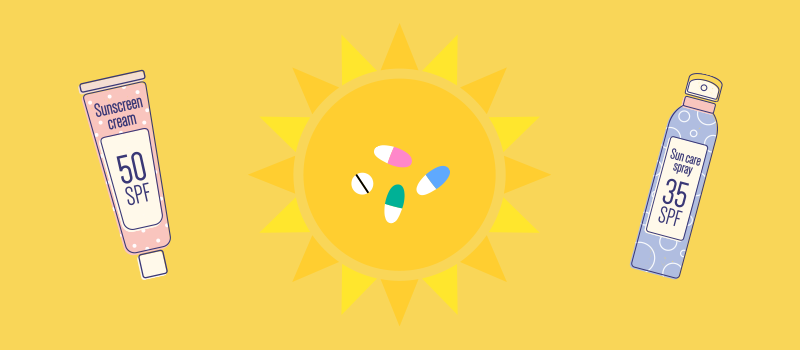What’s the Buzz
The Bee Healthy Blog
Arthritis Medication Uses & Side Effects

Approximately 1 in 4 adults in the United States, about 59 million Americans, are diagnosed with arthritis. The term arthritis includes more than 100 related conditions that cause joint pain, swelling, stiffness, and a reduced range of motion. There are two types of arthritis: osteoarthritis and rheumatoid arthritis (RA). Osteoarthritis is the more common form of arthritis where the cartilage provides a protective cushion at the ends of the bones that slowly break down over time. This condition is known as the “wear and tear” arthritis. Rheumatoid arthritis is an autoimmune condition in which the body’s immune system attacks healthy joints leading to inflammation and pain. Please keep reading to learn more about rheumatoid arthritis treatments.
What over-the-counter and prescription drugs are used to treat rheumatoid arthritis?
Your healthcare provider may prescribe the following rheumatoid arthritis medications to you. Some of these medications can also be used to treat other types of arthritis as well, such as osteoarthritis.
Analgesics
Analgesics or painkillers like acetaminophen (Tylenol) can provide relief from rheumatoid arthritis (RA) pain. They are available over the counter and cause fewer side effects than many other medications. Like with any medications, though rare, acetaminophen can cause a severe allergic reaction that presents with skin rash, hives, itching, swelling of the face, eyes, lips, tongue, or throat, difficulty breathing, and hoarseness. The risk of side effects of Tylenol (acetaminophen) intensified as the dose increases. High doses of acetaminophen can cause liver damage, especially in people with a history of liver disease due to alcohol abuse. However, since Tylenol (acetaminophen) does not have anti-inflammatory effects, it is not the best medicine to treat pain from RA.
Opioid pain medicines are also used to treat RA. Examples include codeine, oxycodone, tramadol, and fentanyl. Being the most potent pain medication, opioids are reserved for the most severe cases of RA or for patients who cannot use NSAIDs (non-steroidal anti-inflammatory drugs), as in those with kidney disease. Under close supervision of a prescriber, opioids are generally used in combination with other RA therapy that works to slow down the disease progression. Side effects of opioids include drowsiness, nausea, and constipation.
Nonsteroidal anti-inflammatory drugs
Nonsteroidal anti-inflammatory drugs (NSAIDs) are the most widely used rheumatoid arthritis drugs used to relieve pain and inflammation. Examples include over-the-counter medications like ibuprofen (Motrin, Advil) and naproxen (Naprosyn, Aleve), diclofenac (Voltaren), as well as prescription drugs like indomethacin (Indocin), celecoxib (Celebrex), and meloxicam (Mobic).
Side effects of NSAIDs include stomach problems such as indigestion, stomach upset, an increase in stomach acid, stomach ulcers, stomach bleeding, dizziness, drowsiness, confusion, fluid retention, weight gain, high blood pressure, and kidney damage, especially with high doses or prolonged use. One disadvantage is that all prescription NSAIDs carry a risk of heart attack and stroke. Inform your doctor if you have a history of heart disease, stomach ulcers, or stomach bleeding.
Corticosteroids
Corticosteroids or steroids are drugs that suppress immune responses. As a result, these medications reduce inflammation and pain from RA. Overall, steroids are effective at relieving inflammation in RA patients. Many people find their symptoms have greatly improved after starting steroids. However, these RA drugs can only be used for short periods to manage RA flares while a person is on other RA treatments. Other RA treatments are very effective at slowing down the disease progression, but it may take some time for these medications to exert all their effects; in these cases, steroids are used to reduce pain and preserve the body's function while other medications kick in.
There are cases where low doses of steroids are prescribed to be used chronically in combination with other RA treatments.
Examples of corticosteroids used to treat rheumatoid arthritis include prednisone, prednisolone, methylprednisolone, dexamethasone, and triamcinolone. Besides pill form and oral syrups, steroids are available as intra-articular injections (injections into the affected joints) and intravenous or intramuscular injections.
Side effects of corticosteroids include an increased risk of infections, weakness, fatigue, high blood pressure, high blood sugar, sleep problems, swelling in the legs, weight gain, mood changes including depression and anxiety, skin irritation at the injection site, increased risk of cataracts, and increased risk of osteoporosis.
Disease-modifying antirheumatic drugs (DMARDs)
Disease-modifying drugs help to slow inflammation and prevent joint damage. These RA medications can take at least a month or longer to start working. Some people need a combination of disease-modifying antirheumatic drugs to relieve RA symptoms. Examples of DMARDs include methotrexate (Trexall, Rheumatrex), sulfasalazine (Azulfidine), hydroxychloroquine (Plaquenil), and leflunomide (Arava).
Side effects and potential risks of taking DMARDs include upset stomach, mouth sores, fever, lowered blood counts, infections, swollen lymph nodes, easy bruising, unusual bleeding, liver problems, reduced liver function, nausea, vomiting, skin rash, headaches, vision problems, nerve damage, increased risk of skin cancer, and increased risk of birth defects.
Biologic treatments
Biologic drugs are a type of DMARDs called targeted biologic agents. They are made using molecular biology techniques and help to reduce inflammation by targeting immune system cells. Examples of these types of rheumatoid arthritis medications include:
- Tumor necrosis factor (TNF) inhibitors like adalimumab (Humira), etanercept (Enbrel), certolizumab pegol, infliximab (Remicade), and golimumab.
- B-cell depleting agents like rituximab (Rituxan).
- Selective costimulation modulators like abatacept (Orencia).
- Interleukin inhibitors like sarilumab, tocilizumab, and anakinra.
- Janus kinase (JAK) inhibitors like tofacitinib (Xeljanz), baricitinib (Olumiant), and upadacitinib (Rinvoq).
Side effects of biologic drugs include an increased risk of upper respiratory infections, lower respiratory infections, urinary tract infections, and herpes zoster. It’s important that you tell your doctor immediately if you develop signs and symptoms of a serious infection while taking DMARDs. You will also need to get all the recommended vaccinations before starting these rheumatoid arthritis medications.
What is the best drug to take for arthritis?
The best drug to take for arthritis depends on the individual patient. In addition to non-pharmacological approaches with exercise, physical therapy, and pain management with NSAIDs, Tylenol (acetaminophen), and opioid medications, the three main types of rheumatoid arthritis drugs are nonsteroidal anti-inflammatory drugs (NSAIDs), corticosteroids (steroids), and disease-modifying antirheumatic drugs (DMARDs).
Most patients begin rheumatoid arthritis treatment with NSAIDs for early signs of rheumatic disease. As the disease progresses, other medications may need to be added. Steroids work quickly to relieve RA pain. DMARDs can take several weeks to months to have an effect. Therefore, corticosteroids are often used to treat severe pain during rheumatoid arthritis flares and to bridge people over until DMARDs take effect. People with moderate to severe RA who do not respond to the recommended dose of one DMARD may be prescribed triple therapy (a combination of three DMARDs).
What is the best arthritis drug with the least side effects?
Your doctor will help you choose the best arthritis drug with the least side effects. You may need to try one or more drugs or a combination of rheumatoid arthritis drugs to find the ones that work and cause the least side effects. Generally speaking, DMARDs like hydroxychloroquine and sulfasalazine are effective for patients with mild rheumatoid arthritis and cause fewer side effects than some of the other DMARDs.
What is the safest drug for arthritis?
Methotrexate is generally regarded as one of the safest drugs to treat rheumatoid arthritis, though it has many side effects, such as nausea and vomiting. Many patients are prescribed a combination of NSAIDs and methotrexate and can take these rheumatoid arthritis medications safely as long as their blood counts and liver function are monitored.
References:
- https://www.cdc.gov/arthritis/data_statistics/national-statistics.html
- https://www.arthritis.org/health-wellness/about-arthritis/understanding-arthritis/what-is-arthritis
- https://www.arthritis.org/health-wellness/treatment/treatment-plan/disease-management/medications-for-arthritis
- https://medlineplus.gov/druginfo/meds/a681004.html
- https://www.cochrane.org/CD003113/MUSKEL_opioid-therapy-for-treating-rheumatoid-arthritis-pain_#
- https://www.ncbi.nlm.nih.gov/pmc/articles/PMC3891482/
- https://www.rheumatoidarthritis.org/treatment/medications/corticosteroids/
- https://www.uptodate.com/contents/disease-modifying-antirheumatic-drugs-dmards-in-rheumatoid-arthritis-beyond-the-basics#
- https://www.hopkinsarthritis.org/arthritis-info/rheumatoid-arthritis/ra-treatment/#
- https://www.ncbi.nlm.nih.gov/pmc/articles/PMC7500842/
- https://www.reumatologiaclinica.org/en-triple-therapy-in-rheumatoid-arthritis-articulo-S217357431400135X
- https://www.arthritis.org/drug-guide/medication-topics/understanding-methotrexate#












SOCIAL